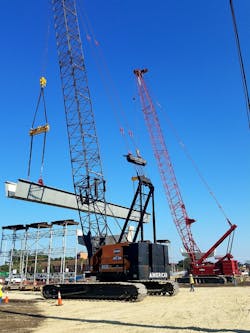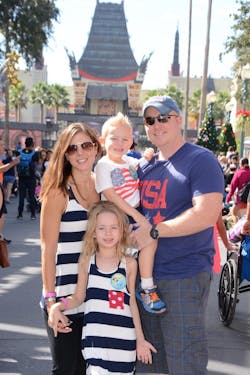Under 40 in Construction Equipment Award winner Ernie Stephens, corporate equipment manager at Superior Construction, in Portage, Ind., earned a Construction Management degree from Bradley University in Peoria, Ill., and could have followed in his family’s footsteps on a career path at Peoria’s Caterpillar.
Our fourth class of Under 40 in Construction Equipment winners was announced in May. These young people, all under the age of 40 as of the end of 2016, represent exciting potential for the industry.
This is another in a series of profiles highlighting some of the winners, past and present.
Instead, he elected to start his journey on the end-user side of the equipment triangle at Chicago’s Walsh Construction.
“I started out right at the bottom, with the technicians on the shop floor,” says Stephens.
Welcome to the big city.
Stephens was a country boy who grew up around machinery. As a teenager, he gained an internship at Caterillar, which he kept throughout college and worked at full-time during the summers. “You kind of thought you’d want to be a Caterpillar guy for life, which is what everyone does in Peoria,” he says. Stephens would have been a third-generation Cat employee had he stayed.
From Caterpillar to equipment manager
But 13 years ago, Stephens’ fortunes changed when he received a call from Peter Walsh of Walsh Construction.
“It was a very cool prospect to take my background, with my education in construction management, and apply the two together,” he says.
At Walsh, Stephens worked his way up from the bottom to doing inbound inspections, then shop management, and then field management. The last thing he wanted during his climb was to be called an “office boy,” but the relationships he forged with others quickly prevented that.
“I think what gave me an advantage is that I was able to start at the bottom and get a rapport with the technicians,” Stephens says. “Those relationships are some of the reasons I’m where I am today. It’s not always about what you know as a person, it’s about how fast you can get that information. Who do you know who has that information? It’s using a Rolodex a lot of the time. You have to surround yourself with good people. And as an equipment manager, you can never be too good at one thing, or too specialized.”
During his tenure at Walsh, Stephens spent five years working with the company’s crane manager helping to oversee more than 200 owned and rental cranes across the country, including tower cranes, crawler cranes, and rough-terrain cranes.
After cranes, he was put in charge of concrete paving equipment, managing over 70 GOMACO pavers and a number of Erie batch plants.
“I had never handled paving equipment before, so the first thing I did was go out to the shop and observe what the techs were doing,” he says. “I also went out to the field and watched our operations. It was pretty awe-inspiring. I didn’t mind working nights and weekends; whatever it took just to learn, help out the crews, and help the company succeed. I think most people noticed that, so they’d take a liking to that, as opposed to seeing an office guy who never gets out.”
Stephens says the best part of his job is that he can vary his time between the shop, the field, and the office. After 12 years at Walsh, however, he was ready for a new challenge.
Develop a fleet department
At the same time, Tim Johnson, Stephens’ first hiring manager at Walsh, had joined Superior Construction as COO, and Johnson needed an equipment manager. It didn’t take long for Stephens and Johnson to reconnect and for Stephens to jump at the opportunity to develop his own equipment department at the fourth-generation, family-owned company.
“There are no boxes here at Superior,” he says. “They really value your input and they’re ready for change.”
In just short of two years at Superior, Stephens has evolved its equipment operations. The task seemed intimidating at first. There were several different areas that needed attention, as well as minds he would have to win over along the way.
“You can’t tell people how to change. You’ve got to show them how to do it and make everyone feel like they are part of the team. And that’s where it started to get really fun,” Stephens says.
“I was able to bring in what we call ‘educated professionals,’ where upside is unlimited,” Stephens says. The hires have resulted in multiple perspectives from diverse backgrounds.
Stephens brought in two key employees: one with a military background and a bachelor’s degree in aviation management, and another was a former Kiewit equipment manager who carries a technical degree in auto/diesel. “Together as a team, you develop five or six new initiatives every year, which in turn usually shake out additional smaller fixes along the way—and that’s how you start making a difference,” Stephens explains.
One of his major goals has been to ensure everyone in the company viewed the equipment department as part of the team rather than an adversary. “Whether it is the job sites, the estimating department, or the executives, they all need to have trust in our abilities as much as they have trust in our equipment,” Stephens says.
“For the operations side, we’re doing our best to modernize the fleet and improve preventive maintenance; with estimating, we’re helping review equipment needed for upcoming bids and providing alternate procurement solutions,” Stephens says. “Communication is the key, as is keeping ourselves accessible to everyone in the company.”
His first initiative was establishing an equipment policy. “We wanted to give everyone a playbook that established common policies and procedures, but was easy to read.” Stephens accomplished it in just 15 pages. It explains what is expected from operations with equipment, as well as what the operations group should expect from the equipment department.
He also challenged project teams to create cost-loaded equipment schedules. “Create an initial schedule of what’s expected for the job’s duration,” Stephens says. “Then, verify accuracy each month and send in updates. This helps the jobs accurately forecast cost and also allows me to have insight on future capex needs.
“The schedules also allow my team to better manage internal assets—it’s sort of like playing chess,” Stephens says. “Give this piece up now, and I’ll have something available for you later when you need it again.”
Power of partnerships
Another key change was leveraging Superior’s buying power. Stephens used his previous relationships with OEMs and brought them to the table for Superior.
“By combining our Midwest and Southeast business units’ accounts, we were able to see significant savings right away,” he says.
Superior’s fleet has an estimated replacement value of over $75 million, and it includes 275-ton down to 30-ton cranes, excavators, wheel loaders, dozers, ADTs, concrete pavers, soil stabilizers, and more.
In building a fleet, Stephens advocates building partnerships with like-minded companies. “With Superior being in such a growth mode, we really have to align ourselves with OEMs that are organized to grow with us, and maybe even take a chance on us right now,” Stephens says. “It’s harder to ask a bigger OEM to do the same because they are already established with so many corporate accounts.
“We have a good partnership with the Wirtgen Group so far,” Stephens says. “They’re also in a growth mode [see related story on page 22], and what’s better to show what they can offer than to have their equipment working on high-profile jobs?”
Stephens notes that the hidden benefit behind all the changes is becoming apparent to upper management. He received positive feedback on a recent visit to the company’s Southeast Division.
“The VP looked over at me one evening and said, ‘I don’t know what you guys are doing, but I’m seeing it.
I see it in the cost report.’ That’s the biggest compliment I have ever received,” Stephens says. “That’s exactly what we’re trying to do here at Superior.”
About the Author
Frank Raczon
Raczon’s writing career spans nearly 25 years, including magazine publishing and public relations work with some of the industry’s major equipment manufacturers. He has won numerous awards in his career, including nods from the Construction Writers Association, the Association of Equipment Manufacturers, and BtoB magazine. He is responsible for the magazine's Buying Files.


